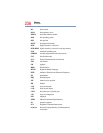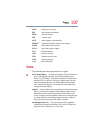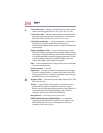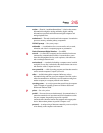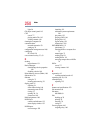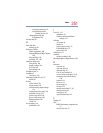
Glossary
Terms
244
L
L1 (level one) cache — Memory cache built into the processor to help
improve processing speed. See also cache, CPU cache, L2 cache.
L2 (level two) cache — Memory cache installed on the motherboard to
help improve processing speed. It is slower than L1 cache and faster
than main memory. See also cache, CPU cache, L1 cache.
LAN (local area network) — A group of computers or other devices
dispersed over a relatively limited area and connected by a
communications link that enables any device to interact with any other
on the network.
liquid crystal display (LCD) — A type of display that uses a liquid
substance between two transparent electrode panels. When an electric
current passes through the electrodes, the molecules in the liquid form
a crystalline pattern that polarizes the light passing through it. A filter
over the electrodes permits only non-polarized light to pass to the
surface of the display, creating light and dark pixels.
load — To move information from a storage device (such as a hard disk)
into memory for processing.
local area network — See LAN.
logical drive — A section of a disk that is recognized by the operating
system as a separate disk drive. A system’s logical drives may differ
from its physical drives. For example, a single hard disk drive may be
partitioned into two or more logical drives.
M
megabyte (MB) — A unit of data equal to 1,048,576 bytes (1024 x 1024
bytes). See also bytes.
memory — Typically refers to the computer’s main memory, where
programs are run and data is temporarily stored and processed.
Memory can be volatile and hold data temporarily, such as RAM, or it
can be nonvolatile and hold data permanently, such as ROM. A
computer’s main memory is RAM. See RAM, ROM.
microprocessor — See central processing unit (CPU).
MIDI (Musical Instrument Digital Interface) — A standard for
connecting musical instruments, synthesizers, and computers. The
MIDI standard provides a way of translating music into a form
computers can use, and vice versa.



